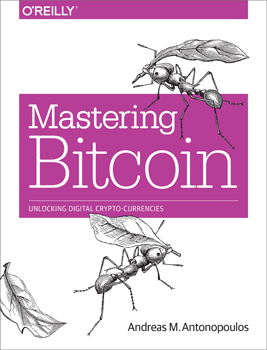"Bitcoin & the Blockchain" entries

More than a currency, bitcoin is an enabling technology
The O'Reilly Radar Podcast: Balaji Srinivasan on the bigger picture of bitcoin, liquid markets, and the future of regulation.
The promise of bitcoin and blockchain extends well beyond its potential disruption as a currency. In this Radar Podcast episode, Balaji Srinivasan, a general partner at Andreessen Horowitz, explains how bitcoin is an enabling technology and why it’s like the Internet, in that “bitcoin will do for value transfer what the Internet did for communication — make it programmable.” I met up with Srinivasan at our recent O’Reilly Radar Summit: Bitcoin & the Blockchain, where he was speaking — you can see his talk, and all the others from the event, in the complete video compilation now available.
The bigger picture of bitcoin
More than just a digital currency, bitcoin can serve as an instigator for new markets. Srinivasan explained the potential for everything to become a liquid market:
“Bitcoin is a platform for programmable money, programmable interchange, or anything of value. That’s very general. People have probably heard at this point about how you can use a blockchain to trade — in theory — stocks, or houses, or other kinds of things, but programmable value transfer is even bigger than just trading things which we know already exist.
“One analogy I would give is in 1988, it was not possible to find information on anything instantly. Today, most of the time it is. From your iPhone or your Android phone, you can google pretty much anything. In the same way, I think what bitcoin is going to mean, is markets in everything. That is, everything will have a price on it — everything will be a liquid market. You’ll be able to buy and sell almost anything. Where today the fixed costs of setting up such a market is too high for anything other than things that are fairly valuable, tomorrow it’ll be possible for even images or things you would not even think of normally buying and selling.”

Bitcoin is just the first app to use blockchain technology
Understanding the value of the blockchain above and beyond bitcoin.
Editor’s note: Lorne Lantz is a program co-chair for our O’Reilly Radar Summit: Bitcoin & the Blockchain on January 27, 2015, in San Francisco. For more on the program and for registration information, visit the Bitcoin & the Blockchain event website.
I remember the first time I heard about bitcoin. It was June 2012, and I was invited to a bitcoin meetup. The whole time I was sitting there, I thought these were a bunch of computer geeks playing around with nerd money.
At the same time, I felt excited about the possibilities. If what the bitcoin believers were saying was true, it could become something very big. When I took a closer look, I realized why it could be so groundbreaking: decentralization.
Unlike other currencies and payment networks, bitcoin is not controlled by a bank, government, or financial institution. Instead, thousands of computers around the world verify transactions and manage a global decentralized ledger. This innovative technology is called the blockchain, and it provides a unique pathway that allows — for the first time — many computers that don’t trust each other to achieve consensus. In bitcoin’s case, they are achieving consensus on updates to the global ledger. Read more…

Blockchain scalability
A look at the stumbling blocks to blockchain scalability and some high-level technical solutions.
Author note: Vitalik Buterin contributed to this article.
Request an invitation to Next:Money, O’Reilly’s conference focused on the fundamental transformation taking place in the finance industry.
In a talk at CoinJar last fall, well-known bitcoin expert Andreas Antonopoulos made the following comment:
“I have no worries that bitcoin can scale, and the simple reason for that is that I know that IPv4 can’t, and yet I use it every day.”
The issue of bitcoin scalability and the phrase “blockchain scalability” are often seen in technical discussions of the bitcoin protocol. Will the requirements of recording every bitcoin transaction in the blockchain compromise its security (because fewer users will keep a copy of the whole blockchain) or its ability to handle a great number of transactions (because new blocks on which transactions can be recorded are only produced at limited intervals)? In this article, we’ll explore several meanings of “blockchain scalability” and some high-level technical solutions to the issue.
The three main stumbling blocks to blockchain scalability are:
- The tendency toward centralization with a growing blockchain: the larger the blockchain grows, the larger the requirements become for storage, bandwidth, and computational power that must be spent by “full nodes” in the network, leading to a risk of much higher centralization if the blockchain becomes large enough that only a few nodes are able to process a block.
- The bitcoin-specific issue that the blockchain has a built-in hard limit of 1 megabyte per block (about 10 minutes), and removing this limit requires a “hard fork” (ie. backward-incompatible change) to the bitcoin protocol.
- The high processing fees currently paid for bitcoin transactions, and the potential for those fees to increase as the network grows. We won’t discuss this too much, but see here for more detail.
We’ll consider these first two issues in detail. Read more…

The 3Ps of the blockchain: platforms, programs and protocols
There is a burgeoning landscape around the blockchain’s decentralized consensus protocol technologies.
Although it may be early to baptize new buzz lingo like “Blockchain as a Service” (BaaS) or “Blockchain as a Platform” (BaaP), there is a burgeoning landscape of various implementations and activity in and around the blockchain’s decentralized consensus protocol technologies.
I’ve already covered the blockchain’s sweet spot as a development platform in “Understanding the blockchain,” so it is no surprise that its landscape will be made up of platforms, protocols, and (smart) programs.
Breaking-up the bitcoin-blockchain paradigm
In a perfect world, we would have a single blockchain and a single cryptocurrency. But that doesn’t seem to be in the cards, whether it is technically feasible or not. Although wide-scale adoption and a critical mass of users aren’t there yet, the market is signaling for a diversification of choices, some based on the bitcoin currency and its blockchain protocol, and others not. Read more…

Security comes from evolution, not revolution
The O'Reilly Radar Podcast: Mike Belshe on making bitcoin secure and easy enough for the mainstream.
Editor’s note: you can subscribe to the O’Reilly Radar Podcast through iTunes, SoundCloud, or directly through our podcast’s RSS feed.
In this week’s O’Reilly Radar Podcast episode, I caught up with Mike Belshe, CTO and co-founder of BitGo, a company that has developed a multi-signature wallet that works with bitcoin. Belshe talks about about the security issues addressed by multi-signature wallets, how the technology works, and the challenges in bringing cryptocurrencies mainstream. We also talk about his journey into the bitcoin world, and he chimes in on what money will look like in the future. Belshe will address the topics of security and multi-signature technology at our upcoming Bitcoin & the Blockchain Radar Summit on January 27, 2015, in San Francisco — for more on the program and registration information, visit our Bitcoin & the Blockchain website.
Multi-signature technology is exactly what it sounds like: instead of authorizing bitcoin transactions with a single signature and a single key (the traditional method), it requires multiple signatures and/or multiple machines — and any combination thereof. The concept initially was developed as a solution for malware. Belshe explains:
“I’m fully convinced that the folks who have been writing various types of malware that steal fairly trivial identity information — logins and passwords that they sell super cheap — they are retooling their viruses, their scanners, their key loggers for bitcoin. We’ve seen evidence of that over the last 12 months, for sure. Without multi-signature, if you do a bitcoin transaction on a machine that’s got any of this bad stuff on it, you’re pretty much toast. Multi-signature was my hope to fix that. What we do is make one signature happen on the server machine, one signature happen on the client machine, your home machine. That way the attacker has to actually compromise two totally different systems in order to steal your bitcoin. That’s what multi-signature is about.”

Security principles of bitcoin
The core principle in bitcoin is decentralization, and it has important implications for security.
Editor’s note: this is an excerpt from Chapter 10 of our recently released book Mastering Bitcoin, by Andreas Antonopoulos. You can read the full chapter here. Antonopoulos will be speaking at our upcoming event Bitcoin & the Blockchain, January 27, 2015, in San Francisco. Find out more about the event and reserve your spot here.
Securing bitcoin is challenging because bitcoin is not an abstract reference to value, like a balance in a bank account. Bitcoin is very much like digital cash or gold. You’ve probably heard the expression “Possession is nine tenths of the law.” Well, in bitcoin, possession is ten tenths of the law. Possession of the keys to unlock the bitcoin, is equivalent to possession of cash or a chunk of precious metal. You can lose it, misplace it, have it stolen, or accidentally give the wrong amount to someone. In every one of those cases, end users would have no recourse, just as if they dropped cash on a public sidewalk.However, bitcoin has capabilities that cash, gold, and bank accounts do not. A bitcoin wallet, containing your keys, can be backed up like any file. It can be stored in multiple copies, even printed on paper for hardcopy backup. You can’t “backup” cash, gold, or bank accounts. Bitcoin is different enough from anything that has come before that we need to think about bitcoin security in a novel way too.
Security principles
The core principle in bitcoin is decentralization and it has important implications for security. A centralized model, such as a traditional bank or payment network, depends on access control and vetting to keep bad actors out of the system. By comparison, a decentralized system like bitcoin pushes the responsibility and control to the end users. Because security of the network is based on Proof-Of-Work, not access control, the network can be open and no encryption is required for bitcoin traffic. Read more…

Introduction to the blockchain
The blockchain is like layers in a geological formation — the deeper you go, the more stability you gain.
Editor’s note: this is an excerpt from Chapter 7 of our recently released book Mastering Bitcoin, by Andreas Antonopoulos. You can read the full chapter here. Antonopoulos will be speaking at our upcoming event Bitcoin & the Blockchain, January 27, 2015, in San Francisco. Find out more about the event and reserve your spot here.
The blockchain data structure is an ordered back-linked list of blocks of transactions. The blockchain can be stored as a flat file, or in a simple database. The bitcoin core client stores the blockchain metadata using Google’s LevelDB database. Blocks are linked “back,” each referring to the previous block in the chain. The blockchain is often visualized as a vertical stack, with blocks layered on top of each other and the first block serving as the foundation of the stack. The visualization of blocks stacked on top of each other results in the use of terms like “height” to refer to the distance from the first block, and “top” or “tip” to refer to the most recently added block.Each block within the blockchain is identified by a hash, generated using the SHA256 cryptographic hash algorithm on the header of the block. Each block also references a previous block, known as the parent block, through the “previous block hash” field in the block header. In other words, each block contains the hash of its parent inside its own header. The sequence of hashes linking each block to its parent creates a chain going back all the way to the first block ever created, known as the genesis block. Read more…

Bitcoin is a digital money ecosystem
Behind the scenes, there's a lot more to bitcoin and blockchain than first meets the eye.
Editor’s note: this is an excerpt from Chapter 1 of our recently released book Mastering Bitcoin, by Andreas Antonopoulos. You can read the full chapter here. Antonopoulos will be speaking at our upcoming event Bitcoin & the Blockchain, January 27, 2015, in San Francisco. Find out more about the event and reserve your spot here.
Bitcoin is a collection of concepts and technologies that form the basis of a digital money ecosystem. Units of currency called bitcoins are used to store and transmit value among participants in the bitcoin network. Bitcoin users communicate with each other using the bitcoin protocol, primarily via the Internet; although, other transport networks can also be used. The bitcoin protocol stack, available as open source software, can be run on a wide range of computing devices, including laptops and smartphones, making the technology easily accessible.Users can transfer bitcoin over the network to do just about anything that can be done with conventional currencies, such as buy and sell goods, send money to people or organizations, or extend credit. Bitcoin technology includes features that are based on encryption and digital signatures to ensure the security of the bitcoin network. Bitcoins can be purchased, sold, and exchanged for other currencies at specialized currency exchanges. Bitcoin, in a sense, is the perfect form of money for the Internet because it is fast, secure, and borderless. Read more…

Clustering bitcoin accounts using heuristics
In this O'Reilly Data Show Podcast: Sarah Meiklejohn on analytic applications for blockchain and cryptocurrency technology.
Editor’s note: we’ll explore present and future applications of cryptocurrency and blockchain technologies at our upcoming Radar Summit: Bitcoin & the Blockchain on Jan. 27, 2015, in San Francisco.
A few data scientists are starting to play around with cryptocurrency data, and as bitcoin and related technologies start gaining traction, I expect more to wade in. As the space matures, there will be many interesting applications based on analytics over the transaction data produced by these technologies. The blockchain — the distributed ledger that contains all bitcoin transactions — is publicly available, and the underlying data set is of modest size. Data scientists can work with this data once it’s loaded into familiar data structures, but producing insights requires some domain knowledge and expertise.
Subscribe to the O’Reilly Data Show Podcast
I recently spoke with Sarah Meiklejohn, a lecturer at UCL, and an expert on computer security and cryptocurrencies. She was part of an academic research team that studied pseudo-anonymity (“pseudonymity”) in bitcoin. In particular, they used transaction data to compare “potential” anonymity to the “actual” anonymity achieved by users. A bitcoin user can use many different public keys, but careful research led to a few heuristics that allowed them to cluster addresses belonging to the same user:
“In theory, a user can go by many different pseudonyms. If that user is careful and keeps the activity of those different pseudonyms separate, completely distinct from one another, then they can really maintain a level of, maybe not anonymity, but again, cryptographically it’s called pseudo-anonymity. So, if they are a legitimate businessman on the one hand, they can use a certain set of pseudonyms for that activity, and then if they are dealing drugs on Silk Road, they might use a completely different set of pseudonyms for that, and you wouldn’t be able to tell that that’s the same user.

Regulation and decentralization: Defending the blockchain
Andreas Antonopoulos urges the Canadian Senate to resist the temptation to centralize bitcoin.
Editor’s note: our O’Reilly Radar Summit: Bitcoin & the Blockchain will take place on January 27, 2015, at Fort Mason in San Francisco. Andreas Antonopoulos, Vitalik Buterin, Naval Ravikant, and Bill Janeway are but a few of the confirmed speakers for the event. Learn more about the event and reserve your ticket here.
We recently announced a Radar summit on present and future applications of cryptocurrencies and blockchain technologies. In a webcast presentation one of our program chairs, Kieren James-Lubin, observed that we’re very much in the early days of these technologies. He also noted that the technologies are complex enough that most users will rely on service providers (like wallets) to securely store, transfer, and receive cryptocurrencies.
As some of these service providers reach a certain scale, they will start coming under the scrutiny of regulators. Certain tenets are likely to remain: currencies require continuous liquidity and large financial institutions need access to the lender of last resort.
There are also cultural norms that take time to change. Take the example of notaries, whose services seem amenable to being replaced by blockchain technologies. Such a wholesale change would entail adjusting rules and norms across localities, which means going up against the lobbying efforts of established incumbents.
One way to sway regulators and skeptics is to point out that the decentralized nature of the (bitcoin) blockchain can unlock innovation in financial services and other industries. Mastering Bitcoin author Andreas Antonopoulos did a masterful job highlighting this in his recent testimony before the Canadian Senate:
“Traditional models for financial payment networks and banking rely on centralized control in order to provide security. The architecture of a traditional financial network is built around a central authority, such as a clearinghouse. As a result, security and authority have to be vested in that central actor. The resulting security model looks like a series of concentric circles with very limited access to the center and increasing access as we move farther away from the center. However, even the most outermost circle cannot afford open access.




